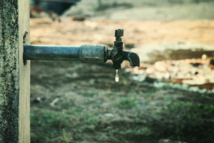Residents of the region are complaining that they have no opportunity to take a bath for few days. Hot climate aggravates the problem, not only in terms of hygiene, but also in terms of public health.
Of course, India is not alone in the issue of water scarcity. However, the situation is complicated with two factors: the acute shortage of water after low-intensity monsoon rains seasons, as well as a chronic problem of depletion of water resources.
All of this affects both agriculture and the urban population of India, which is nearly 1.3 billion people.
This year, already 10 of the 29 Indian states have announced the drought.
Despite the fact that economic growth in India is still above 7%, overtaking China in this indicator, such a large-scale drought could seriously damage the country's farmers. In the long run, ineffective water disposal is likely to have a serious negative impact on the agricultural sector and more broadly throughout the economy.
However, not everyone is raising alarm. The water resources ministry pointed out that neither the political class nor the intellectuals still understand to what extent the water crisis may hit the country's economy.
The Ministry noted that rural areas may soon lash out. This may eventually lead to a real struggle for water between states.
Officials have expressed concern that if they do nothing to solve this problem, the future will bring real "water wars" to the country.
Low-intensity monsoon brought rains 12-14% lower than the average levels in 2014 and 2015. This has only added to concerns about the shortage of water resources in the country during the drought season.
In some parts of India, the water is supplied in trucks or trains. In some states, the legislation has already prohibited gatherings near water sources. This law aims to prevent fights over water.
In addition, a large power plant that runs on coal and uses water from the Ganges River for cooling, was forced to suspend work for six months due to a shortage of water in the channel.
Environmentalists, who believe that Coca-Cola is using too much water from underground sources, have made the company shut down five plants, despite the fact that the producer itself states that only a small percentage of water is taken from underground sources.
It is noted at the time that the five plants were closed due to the optimization of production.
However, the real problem is not about the absolute water scarcity.
In fact, rainfalls in India are quite abundant, yet seasonal. Rivers in the north are also fed by snowmelt in the Himalayas.
The real cause of water shortage in India is a very rapid increase in the population, an inefficient transportation system, the use of crops such as rice or sugar beet, which require copious irrigation, in arid areas of the country, as well as the inability to control the demand for water because of the free electricity and subsidizing diesel fuel.
It is not that the channels are being dried up or farmers are excessively wasting water, which the state gives them. The owners of land can produce as much water as they need, pumping it out of their lands.
According to a recent study of the European Commission in India, the number of wells increased from 10 thousand in 1960 to more than 20 million todays.
India, according to this study, pumps 230 billion cubic meters of groundwater - more than any other country.
Over 60% of irrigated agriculture and 85% of drinking water falls on groundwater.
There is also climate change, which also had an impact on the water problem in the country.
According to forecasts, the temperature in India will be rising, and the rains will become less predictable. This, in turn, will also lead to an increase in the use of water.
Representatives of the government and environmental organizations agree that now they need to take every effort to prevent watery catastrophe in the future.
However, the situation in India is not unique. People in different regions of the world are faced with a similar problem while using different methods to resolve this issue.
For example, in California has been experiencing drought for the fifth year in a row. Experts note that this is the most large-scale drought in the last 1,200 years.
Local authorities are trying to control the level of water use. In addition, they are installing desalination stations everywhere.
Nevertheless, it doesn’t help much. Agriculture in the state is damaged very badly, and the authorities fear that the negative effects will eventually only increase.
Politicians and activists in various countries are trying to find a way to eliminate the imbalance of water in the world, yet all attempts have been unsuccessful so far.
This is worrying because, according to experts, in the near future we may see regional conflicts over water resources. Alarm bells are already sounding in different parts of the world, which shows what future holds in stock.
source: firstpost.com
Of course, India is not alone in the issue of water scarcity. However, the situation is complicated with two factors: the acute shortage of water after low-intensity monsoon rains seasons, as well as a chronic problem of depletion of water resources.
All of this affects both agriculture and the urban population of India, which is nearly 1.3 billion people.
This year, already 10 of the 29 Indian states have announced the drought.
Despite the fact that economic growth in India is still above 7%, overtaking China in this indicator, such a large-scale drought could seriously damage the country's farmers. In the long run, ineffective water disposal is likely to have a serious negative impact on the agricultural sector and more broadly throughout the economy.
However, not everyone is raising alarm. The water resources ministry pointed out that neither the political class nor the intellectuals still understand to what extent the water crisis may hit the country's economy.
The Ministry noted that rural areas may soon lash out. This may eventually lead to a real struggle for water between states.
Officials have expressed concern that if they do nothing to solve this problem, the future will bring real "water wars" to the country.
Low-intensity monsoon brought rains 12-14% lower than the average levels in 2014 and 2015. This has only added to concerns about the shortage of water resources in the country during the drought season.
In some parts of India, the water is supplied in trucks or trains. In some states, the legislation has already prohibited gatherings near water sources. This law aims to prevent fights over water.
In addition, a large power plant that runs on coal and uses water from the Ganges River for cooling, was forced to suspend work for six months due to a shortage of water in the channel.
Environmentalists, who believe that Coca-Cola is using too much water from underground sources, have made the company shut down five plants, despite the fact that the producer itself states that only a small percentage of water is taken from underground sources.
It is noted at the time that the five plants were closed due to the optimization of production.
However, the real problem is not about the absolute water scarcity.
In fact, rainfalls in India are quite abundant, yet seasonal. Rivers in the north are also fed by snowmelt in the Himalayas.
The real cause of water shortage in India is a very rapid increase in the population, an inefficient transportation system, the use of crops such as rice or sugar beet, which require copious irrigation, in arid areas of the country, as well as the inability to control the demand for water because of the free electricity and subsidizing diesel fuel.
It is not that the channels are being dried up or farmers are excessively wasting water, which the state gives them. The owners of land can produce as much water as they need, pumping it out of their lands.
According to a recent study of the European Commission in India, the number of wells increased from 10 thousand in 1960 to more than 20 million todays.
India, according to this study, pumps 230 billion cubic meters of groundwater - more than any other country.
Over 60% of irrigated agriculture and 85% of drinking water falls on groundwater.
There is also climate change, which also had an impact on the water problem in the country.
According to forecasts, the temperature in India will be rising, and the rains will become less predictable. This, in turn, will also lead to an increase in the use of water.
Representatives of the government and environmental organizations agree that now they need to take every effort to prevent watery catastrophe in the future.
However, the situation in India is not unique. People in different regions of the world are faced with a similar problem while using different methods to resolve this issue.
For example, in California has been experiencing drought for the fifth year in a row. Experts note that this is the most large-scale drought in the last 1,200 years.
Local authorities are trying to control the level of water use. In addition, they are installing desalination stations everywhere.
Nevertheless, it doesn’t help much. Agriculture in the state is damaged very badly, and the authorities fear that the negative effects will eventually only increase.
Politicians and activists in various countries are trying to find a way to eliminate the imbalance of water in the world, yet all attempts have been unsuccessful so far.
This is worrying because, according to experts, in the near future we may see regional conflicts over water resources. Alarm bells are already sounding in different parts of the world, which shows what future holds in stock.
source: firstpost.com



















